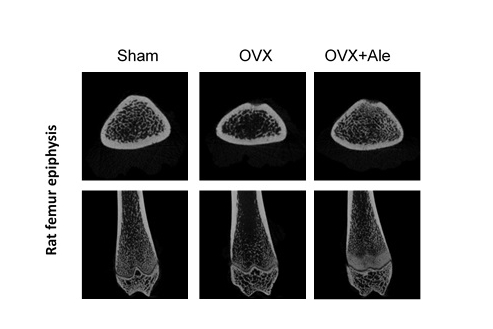Validated assays for in vitro cytotoxicity and in vivo biocompatibility evaluation in regenerative medicine; also animal implantation models to validate...

Advancing Preclinical Research in Osteoarticular Diseases
Discover our specialized preclinical services for osteoporosis, osteoarthritis, rheumatoid arthritis, ostegenesis imperfecta, osteosarcoma and other rare bone diseases.
Our in vitro, in vivo, and ex vivo expertise is tailored to meet your specific needs.
Osteoarticular diseases such as osteoarthritis, rheumatoid arthritis or osteoporosis involve complex cellular and molecular interactions. These can include inflammation, bone remodeling (and unbalance between bone formation and bone resorption), and cartilage degradation. Identifying effective and safe therapeutic targets requires advanced tools and reliable cellular and animal models.
Osteoporosis
Osteoporosis research has seen significant progress with advancements in both anti-resorptive and bone-forming therapies. Traditional treatments, such as bisphosphonates and selective estrogen receptor modulators, remain the standard for managing bone loss bylimiting resorption. However, these treatments have limitations, including potential long-term effects on bone remodeling and flexibility.
Recent innovations we can cite include biologics like denosumab, a monoclonal antibody targeting the RANKL protein, which effectively reduces bone resorption. Additionally, romosozumab, an antibody against sclerostin, shows dual effects by promoting bone formation and reducing resorption, making it particularly effective in postmenopausal osteoporosis. Such therapies have demonstrated superior effect in bone density increase and fracture risks reduction compared to older drugs.
 Healthy bone vs pathological one (osteoporotic rat, 3D reconstruction from microCT)
Healthy bone vs pathological one (osteoporotic rat, 3D reconstruction from microCT)
Emerging approaches focus on targeting molecular pathways such as Wnt signaling, which regulates bone formation. Thos treaments may enhance osteoblast activity while minimizing risks of off-target effects. Novel delivery systems, including nanocarriers and biomaterials, and potential gene or cell therapies are also under investigation.
Know more on our in vivo osteoporosis services
Arthritis & Osteoarthritis
Current arthritis treatments (DMARD: Disease Modifying AntiRheumatic Drug), such as NSAID, methotrexate and biologics, focus on reducing inflammation and halting disease progression. However, those treatments present limitations, side effects and variable patient response. Emerging therapies aim to overcome these barriers by targeting specific pathways. For example, JAK inhibitors may offer an oral alternative for rheumatoid arthritis, while new biologics aim to modulate cytokines like IL-6 or TNF.
Research into small molecules and gene therapies is advancing, including CRISPR applications to modify immune responses. Combination therapies are also being explored to enhance efficacy and durability. These innovations, supported by biomarkers for precision medicine, show promise in personalized medicine for arthritis.
Osteoarthritis remains one of the biggest unmet medical need among musculoskeletal conditions. In addition to research on DMOAD (Disease Modifying OsteoArthritis Drug), recent studies on intra-articular injectable gels are showing promise as innovative treatments for osteoarthritis. These gels aim to improve lubrication, and reduce mechanical strains thus limiting the pain and rigidity associated with joint degeneration in order to delay or avoid invasive surgeries like joint replacements.
Unlike conventional hyaluronic acid injections that primarily act as lubricants, new options are exploring the combination of the hyaluronic acid with DMOAD, aiming to combine the mechanical support with a more curative approach targeting either cartilage degradation or promoting cartilage formation. . These durable effects not only reduces pain but also improves joint function.
Know more on our in vivo inflammatory services
In vitro and ex vivo models applied to dermocosmetics products to better understand mechanism of actions of compounds and products...
Preclinical models applied to inflammatory diseases to better understand mechanism of actions of compounds and treatment efficacy
Robust models on tumoral cell lines and in vivo oncological models to validate future drugs for bone cancer, bone metastases...